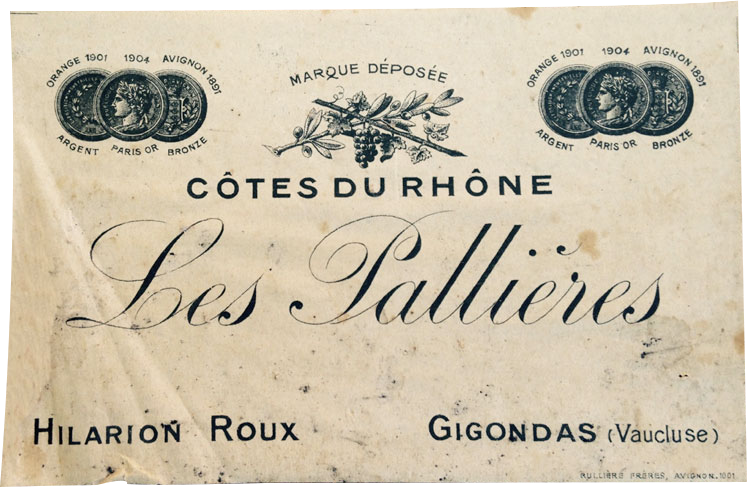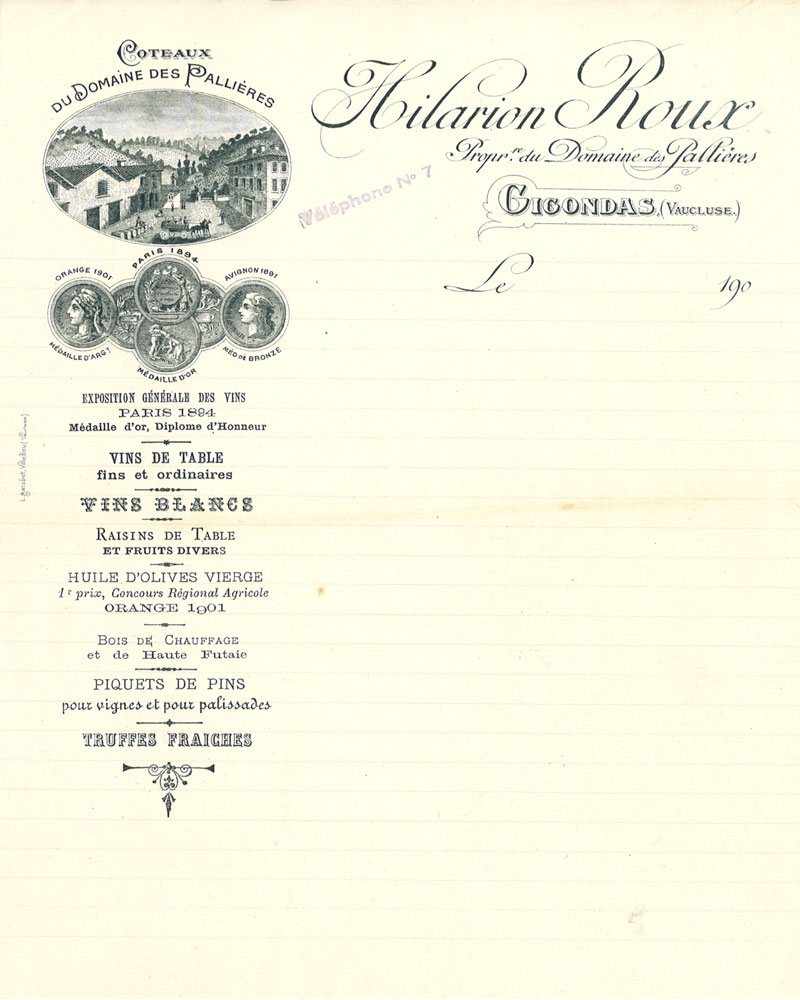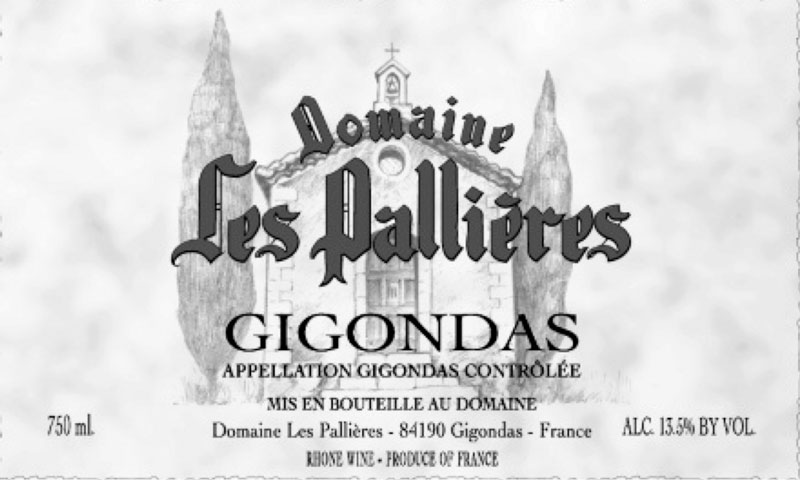History
First century BC
The village of Gigondas was at first called Gigundaz (1138), from the Latin Jocondatisa toponym evoking joy and elation. Such a name was predestined for vine and wine culture, and for the development of authentic vigneron traditions over two millennia...
The veterans of the Second Roman Legion, who in the first century BC founded the Colonia Julia Arausio (i.e. the town of Orange), are thought to have established the village's first vineyards.
Circa 1120
Rostang III, Bishop of Vaison, gifted to his cathedral a plot of land that included a vineyard in Gigondas, near the River Ouvèze. He did so in these terms: “Petro vero Alberto Gigundatis pro vinea quae sita est juxta viam publicam est inter (... otam) episcopalem et fluvium Ovicœ solidis ordo dedit” ("Pierre, also named Albert of Gigondas, was given eight sous for a vine located near the public way between the bishop's mound and the River Ouvèze"). This is the oldest deed confirming the existence of a vineyard within the village boundary.
By the 14th century, vines covered a vast expanse, according to the notarial records. They appear to have yielded good wines, because in 1341 Raymond des Baux, Prince of Orange, granted certain grazing freedoms to the villagers on condition they paid their dues with, in particular, their own wine.
1376
The first mention of a vineyard name in Gigondas refers to “Les Bosquets”.In the 15th century, notarial deeds provide the following names of localities and districts: Les Hautes and Basses Garrigues, Teyssonnières, Chanteduc, Ventolon, Pallières, Trignon, Beaumettes and La Coste de Saint-Cosme.
1694
This was probably the year when the first man named Roux set foot in Pallières, and the estate stayed in the family until 1998. An era spanning three hundred years and more…
1765
The Chapel of Notre-Dame de Grâce was built by a Roux family ancestor. This is doubtless why it is a relatively long way from the village centre, but its construction primarily reflects the wealth of the estate’s owners.
During the 17th century, some residents of Gigondas seem to have given up vines and switched to growing olive and mulberry trees, which required less care. But there were still plenty of vineyards, which justified a proclamation to begin harvesting. Any infringement resulted in a fine, set at five pounds in 1771.
In the 18th and 19th centuries, documents noted that the municipality was “fertile in wine”.
1894
A Domaine de Pallières wines earned its first gold medal at the Concours Général Agricole in Paris.
The estate long farmed multiple crops – olives, apricots, truffles, and vines for wine and table grapes – as well as breeding silkworms.
Successive bequests seriously fragmented the estate: by the early 1950s, Hilarion Roux owned the house and scattered plots, which made up a 15-hectare property. He then began a policy of buying and clearing land, which resulted in the estate as it is today.
___________________________
Text found in a small notebook, written by Hilarion Roux
Gigondas, 5 March 1907
While going through the family's old deeds and papers, which start in 1602, I find mentioned in a letter dated 23 April 1759, addressed to the most illustrious and reverend BIshop of Orange, Lord Baron of the Domaine de Gigondas, signed by François Roux, that:
In the year 1729, Mr Eymeri, clerk to the domaine of the Principality of Orange, had sold for two deniers, the land where our spring lies at Mourre de Piégu. This sale was ratified, approved and confirmed by the legal counsel of the Bishop of Orange, a man named Roux, a priest living in Saint-André des Ramières in the Bishop's Château, who received a proxy from Maître Bouvier, a notary in Gigondas, on 25 February 1758, but since 1756 he had been administering the matter pursuant to a waiver issued by notarial deed in Caderousse on 9 September 1763.
Search to be done at the office of Maître Benoît in Sablet:
1) A deed of exchange between Pascal Roux and the municipality on 2 September 1694
2) Another between the same, 3 September 1696
3) A deed between Tarende (?) and the Roux family
___________________________
1956
When the bitterly cold winter of 1956 killed the olive trees that had survived the big freeze of 1929, Hilarion Roux decided to plant vines in their stead. Some of the current plantings date from that time.
1971
The vine growers of Gigondas had since 1924 emphasised how carefully they made their wines, stating on their harvest declaration that they intended to give them the “appellation d’origine Gigondas”. Although the “Côtes-du-Rhône-Villages” appellation was created, the unsatisfied growers applied several times to obtain a “Gigondas” appellation, which they finally secured on 6 January 1971. It was the first Côtes-du-Rhône Villages appellation to receive this honour!
1980
Hilarion Roux retired, and his three sons – Pierre, the eldest, Maxime and Christian – jointly inherited the estate and set up a specific type of farming company (Groupement Foncier Agricole) that owned the vineyard, homes and woodland. Pierre and Christian had long helped their father Hilarion, who, respecting the old traditions, skilfully made a Gigondas wine which, claimed an estate brochure, would “lead a saint to damnation”.
1998
Pierre and Maxime Roux sold the estate, having carefully chosen their successors. Daniel and Frédéric Brunier (from Domaine du Vieux Télégraphe in Châteauneuf-du-Pape) became co-owners of Les Pallières alongside their friend Kermit Lynch, who had been their US importer since 1978.
2003
The vat room underwent a complete overhaul. Crop intake, temperature control system, vats – everything changed.
2007
The single red wine produced at Domaine Les Pallières became two plot-specific cuvées: Les Racines and Terrasse du Diable.
2012
A goat farm was established at Les Pallières, the idea being to involve the herd in the life of the place. The first cheeses were made…
Here are some of the prices at which the estate’s wine has been sold since 1820:
- 1891 45 francs per hectolitre
- 1893 1 franc per bottle
- 1919 400 francs per 228 litre barrel
For sale to merchants in Burgundy:
- 1920 700 francs per 228 litre barrel
- 1928 725 francs per 228 litre barrel
- 1932 9 francs per bottle (0.75 litre)
- 1973 12 francs per bottle
Early accolades for Domaine Les Pallières:
1891 bronze medal at the Exposition d’Avignon
1894 gold medal at the Concours Agricole de Paris
1901 gold medal (vine cultivation) at the Concours du Département du Vaucluse
1914 bronze medal at the Exposition Internationale de Lyon
1921 silver medal at the Exposition des Vins d’Orange
1923 gold and silver-gilt medals at the Exposition Agricole de Paris



Gigondas: a blessed village
At the centre of the triangle formed by Carpentras, Orange and Vaison-la-Romaine, at the foot of the Dentelles de Montmirail massif, Gigondas – which used to be administratively attached to Carpentras – has to an extent lost touch with its former capital.
Yet some remnants of the past still remain: a few documents; the village ramparts, most of which are still visible, together with the restored castle; and the hunting horn of Prince Guillaume d’Orange, which features in the village’s coat of arms.
The village’s history has a strong religious element. In the 16th century, there were six chapels and churches in the municipality; still there today are the parish church and the magnificent remains of the Romanesque Chapel of Saint-Cosme and Saint-Damien. And for at least nine centuries, there was also a convent here.
Before the Middle Ages
The countless coins, pottery items and roof tiles discovered throughout Gigondas, as well as a collection of capitals and columns, testify to the Romans’ presence. Although the spot was indeed colonised by the Romans – the area was gifted to Roman army veterans, as proven by digs and accidental unearthings on farmland of lead tombs for cremation and the unguent vessels, statuettes, lamps, flat tiles, etc. – there are few archaeological remnants relating to vines or wine. Only a head of Bacchus was discovered in 1866, by Eugène Raspail – nephew of the famous chemist, physician and politician François-Vincent Raspail – on his land at Château Raspail.
The village of Gigondas was at first called Gigundaz (1138), from the Latin Jocondatisa toponym evoking joy and elation. Such a name was predestined for vine and wine culture, and for the development of authentic vigneron traditions over two millennia...
The veterans of the Second Roman Legion, who in the first century BC founded the Colonia Julia Arausio (i.e. the town of Orange), are thought to have established the village's first vineyards.
Middle Ages
Five families ruled over the area of Orange from 793 AD until it was attached to France in 1731.
793-1173: family of the Counts of Toulouse
Circa 800, after the barbarian invasions and Saracen raids, the residents grouped together to form a village. During this period, the County of Orange was created by a legendary character: Guillaume au Court Nez (“William the Short Nose”, or William of Gellone), a companion of Charlemagne.
In the 10th century, Orange and Gigondas were part of the marquessate of Provence.
Circa 1120, Rostang III, Bishop of Vaison, gifted to his cathedral a plot of land that included a vine in Gigondas, near the River Ouvèze. He did so in these terms: “Petro vero Alberto Gigundatis pro vinea quae sita est juxta viam publicam est inter (... otam) episcopalem et fluvium Ovicœ solidis ordo dedit” ("Pierre, also called Albert of Gigondas, was given eight sous for a vine located near the public way between the bishop's mound and the River Ouvèze").
This is the oldest document confirming the existence of a vineyard in this terroir.
In 1150, the last member of the Adhémar dynasty (founded by Guillaume) obtained the title of prince before handing the county to to the Les Baux family.
1173-1393: Des Baux family
1393-1530: Chalon family
1530-1703: Nassau family
1703-1731: Conti family
In 1731, after the Treaty of Utrecht, under an exchange agreement between the Prince de Conti and French King Louis XV, the Principality of Orange was incorporated into the Royal Domain by an act dated 29 May 1731.
Principality of Orange
Gigondas is one of the municipalities that for nearly eight centuries made up the Principality of Orange (1150-1731). The principality formed a narrow belt running east-west between the River Rhône and the Dentelles de Montmirail massif.
It also included the following communities: Causans (now part of the municipality of Jonquières), Châteauneuf-de-Redortier (now part of Suzette), Courthézon, Derboux (now part of Mondragon), Jonquières, Montmirail, Orange, Saint-André-de-Ramières (now part of Violès), Suzette and Violès.
The next clue as to how the Gigondas vineyards, jewel in the crown of the Princes of Orange, developed dates from the 14th century. In July 1341 one of these princes, Raymond V des Baux, granted the villagers various freedoms in return for a 20th of the wine they produced for a seven-year period; but he retained his right to dispense high and low justice.
In 1376, notarial records indicated the existence, in the locality of Les Bosquets, of “vinea culta”; and a deed dating from 1380, in the records of the notaries of Oussan, stated that vines covered an area extending from the Chapel of Notre-Dame des Pallières down to the River Ouvèze.
Renaissance
The same records show that, throughout the 15th century, the vineyards stretched from Les Garrigues to Trignon, also taking in the localities of Beaumette and Coste de Saint-Cosme.
In 1563, Gigondas was captured by the Calvinists.
In the next century, the Village Council drafted its by-laws and approved them on 14 November 1591. Article 45, entitled “Concerning those who sell wine in bulk who must sell it to the other villagers”, set out very clearly the terms of this wholesale trade: “Any person wishing to sell wine in bulk to persons from outside the village shall be bound to sell to the inhabitants of said place, in quarts or pichets, for the price at which they would have sold it to said strangers, subject to paying XII deniers per person and time should they infringe said rule; and whosoever has wine to sell, and sells it in bulk to inhabitants, shall be bound to sell it to all villagers, in quarts ou pichets, to fill barrels, at the price at which would have sold it in bulk, in order to top up said barrels, subject to paying a fine of two sols should they infringe said rule.”
Modern times
In September 1791, the National Constituent Assembly passed a decree, as proposed by the parliamentarian Armand-Gaston Camus, to “incorporate into the French Empire the two combined States of Avignon and the Comtat Venaissin”.
In June 1793, the French National Convention passed a decree “relating to the creation of an 87th department, named the Department of Vaucluse”.
The Department of Vaucluse was thus formed permanently by combining: the City-State of Avignon; the Comtat Venaissin, including the papal enclave in the Drôme, which became the Canton of Valréas; the principalities of Orange and Mondragon; the Viguerie [administrative court jurisdiction] of Apt and the County of Sault.
Five of the six bishoprics in the new department – Apt, Carpentras, Cavaillon, Orange and Vaison – were abolished, leaving only the Archbishopric of Avignon.
Pope Pius VI, who faced the threat of the French armies led by General Bonaparte invading the other Papal States, signed the Treaty of Tolentino on 19 February 1797.
GIGONDAS: ITS WINES, ITS LAND, ITS PEOPLE
Jean-Baptiste Amadieu (historian), Louis Barruol (vigneron), Ilka Kramer (photographer), Véronique Raisin and John Livingstone-Learmonth (journalists), Georges Truc (geologist)
2012
The Roux family, several members of which have been consuls of Gigondas, is one of the oldest in the district. Hilarion Roux was one of the first in Gigondas to organize a union for village wine production in the first decades of the 20th century. Among the many prizes he won during his winemaking career, he was awarded the gold medal at the “Concours Général Agricole” (France’s annual nation agricultural competition) in Paris in 1894. Generations of the Roux family have been involved in shaping the vineyard into what has been described by one enthusiast as a ‘superb garden of grapevines clinging to the side of the Dentelles de Montmirail’. Les Pallières is a very large terroir at a slight altitude (250-400 metres), surrounded by 110 hectares of Mediterranean woodland that also belongs to the estate. Here, the sandy marl mixed with limestone gravel plucked from the Dentelles by water erosion has a very distinctive structure and texture. With its north to northwest orientation and its semicircular sloping topography, Les Pallières is much more than a microclimate – it’s an “environment” that has been created by the Roux family over the centuries.
Everything here is different: the plants seem to have found an ideally well-suited terrain. Arriving at Les Pallières by the scenic road that wind along the valley of Trignon, this Provençal harmony is immediately apparent: one feels welcomed by nature and the people that look after it.
A vertical tasting of old wine from Les Pallières with the late-lamented Pierre Roux was always a great moment, particularly the extraordinary vintages of 1971, 1978 and 1985, which reached the heights of elegance and complexity.
In 1998, Daniel and Fréderic Brunier (Domaine du Vieux Télégraphe in Châteaneuf-du-Pape) became the owners of Les Pallières with the American wine importer Kermit Lynch, sealing an association that had begun 20 years earlier when the first cases of Vieux Télégraphe were exported to the United States. Daniel and Fréderic Brunier’s knowledge of Grenache alongside Kermit Lynch’s long experience as a wine importer (he has been importing wine from several Gigondas estates since the 1970s), were the best guarantee the Les Pallières would continue to be a touchstone for Gigondas wines.
The first years were dedicated to putting the 25-hectare vineyard in order. Two hectares of vines were pulled out and replanted. In 2002, a new wine facility was built, based on the innovative ideas of the estate’s new owners, but guided by the needs of the terroir and its old vines. The new features include a gravity-flow winery and a winemaking process that now allows each parcel to be separately turned into wine, giving each the attention specific to its character it deserves. The wine is matured using traditional oak foudres (large casks). The wines are not filtered. Kermit, Daniel and Frédéric share an approach based on respect for the importance of terroir. Their work is precise, meticulous and, above all, focused on the future. Silence is golden. The Grenache (80%), Syrah, Cinsault, Mourvèdre and Clairette of Les Pallières wouldn’t know how to be treated any other way. Les Pallières' wines could not be anything else but great wines from a great terroir. So it is fortunate that the history of the estate has been given a new dynamic while preserving the best aspects of its past. Domaine Les Pallières’s new direction will ensure that wine enthusiasts around the world will be able to ‘taste the terroir of Les Pallières’ for a long time to come.

